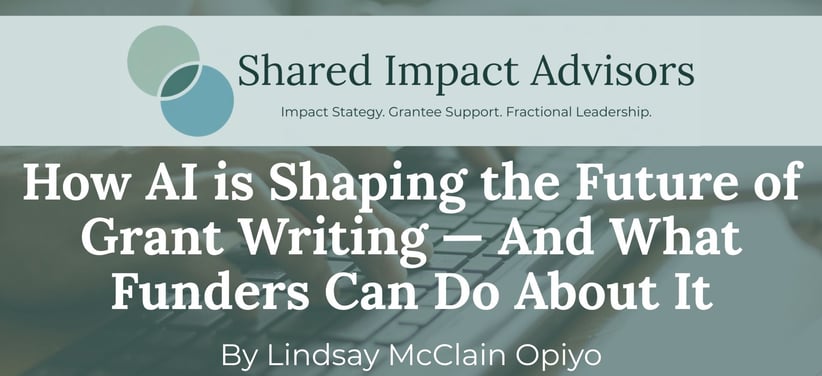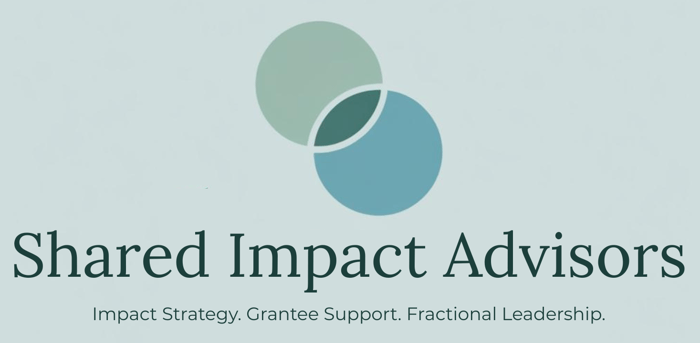AI is Shaping Grant Writing — What Funders Can Do
AI-generated grant proposals are on the rise. Learn 6 ways funders can adapt their review process to stay fair, effective, and community-centered.
Lindsay McClain Opiyo
6/2/20254 min read


I recently supported a funder in reviewing applications for seed grants that support intercultural dialogue around the world. Within days of opening their annual call for proposals, they received an overwhelming number of applications — far more than expected.
But it wasn’t just the volume that stood out.
Proposal after proposal began to blur together. Many described nearly identical activities — storytelling circles, intercultural festivals, virtual dialogues — and used remarkably similar language to explain that intercultural dialogue wasn’t just a component of the project, but its very core. It quickly became clear: some applicants were using AI tools not just to write proposals, but to generate the ideas themselves.
This funder, like many others, is grappling with how to respond to the new reality: AI is here, and it’s reshaping both how grants are written and how they’re reviewed.
The Double-Edged Sword of AI in Grantmaking
With shrinking government budgets, rising competition for funding, and limited internal capacity, AI tools are becoming a go-to for grant seekers aiming to strengthen their proposals and stand out. In some cases, these tools can be genuinely helpful. For organizations working in a second language or with limited staff capacity, AI can help express ideas more clearly and concisely. For funders, AI can offer efficiencies in reviewing proposals, managing data, and identifying patterns across submissions.
But from a funder perspective, AI-generated content creates new challenges:
Who can actually do the work proposed versus who just sounds like they can?
How do we assess authenticity, feasibility, and innovation when proposals start to look and sound the same?
Should we encourage or discourage AI use in the grant writing process?
AI isn’t inherently bad. It can support greater equity in who gets to tell their story and access funding, create new efficiencies, and help both grant seekers and grantmakers do more with limited resources. But how it’s used — and how funders respond — matters.
How Funders Can Respond to AI in Grant Proposals
Here are a few practical steps funders can take as they navigate AI in the proposal development process:
Set clear expectations about AI use. Consider adding a note in your RFPs to clarify whether and how AI should be used. Encourage applicants to submit proposals grounded in their lived experience and direct knowledge of community needs. Let them know proposals are reviewed for depth and originality — not just polish. In many cases, it’s clear when AI is doing the heavy lifting, and it rarely captures the nuance of effective, community-led design.
Incorporate participatory review processes. As proposal volume grows, funders can bring in former or current grantees to help review proposals. Peer or community-based reviews can offer fresh perspectives and help cut through generic language. A recent example: the Olympism365 Innovation Hub included a peer-review step where shortlisted applicants reviewed others’ proposals, with final recommendations made based on peer scores. This not only helps manage volume, but also strengthens transparency and equity in decision-making.
Transparently cap the review pool. To manage expectations and reviewer capacity, funders can encourage early submissions and clearly state limits on how many proposals will be reviewed — for example, reviewing only the first X submissions or reviewing on a rolling basis and closing the call once a diverse and qualified applicant pool is reached. This helps reduce wasted effort for both applicants and reviewers.
Use screening questions to filter early. Simple yes/no or multiple-choice questions — like number of years experience, requested budget, or project start date — can help funders quickly screen for fit before doing deeper review. These can be built into application platforms to stop ineligible proposals from advancing, or used behind the scenes by reviewers.
Invite short videos in place of long narratives. Encourage applicants to submit a short, unpolished video — even a quick phone recording — that shares their idea and the problem it addresses. No editing or fancy production needed — just a genuine explanation in their own words. This helps capture the heart of a project more authentically than a polished written narrative, and often reduces barriers for grassroots applicants. For example, the Gratitude Network includes a video submission in their fellowship application process, helping them select up to 30 fellows each year from an applicant pool of over 1,500.
Build relationships through guidance and accompaniment. As AI makes it easier to generate polished proposals, funders may need more human touchpoints to understand the people and thinking behind the application. Adding a step between the concept note and full proposal — like a scoping call or mentor pairing — helps explore alignment early, clarify expectations, and build trust. Assigning a point person or past grantee to support shortlisted applicants through the full proposal development process often leads to stronger proposals and more transparent relationships from the start. At Lisle International, every shortlisted applicant is paired with a mentor who offers guidance, context, and candid feedback — not only strengthening the full proposal, but also laying the groundwork for trust and open communication throughout project implementation.
For Grantseekers: Use AI Thoughtfully — Don’t Let It Flatten Your Voice
If you’re using AI to support your proposal writing, treat it as a tool — not a shortcut. Funders can often tell when a proposal relies too heavily on AI, especially when ideas feel vague or disconnected from lived experience.
To stand out:
Tailor your proposal to your specific context. Use your own words, grounded in your organization’s unique approach.
Cite relevant data and research, and include SMART goals (specific, measurable, achievable, relevant, and time-bound).
Demonstrate your credibility by showcasing past success, your team’s technical expertise, or partnerships that bring needed capabilities.
Be honest if your idea is new territory. Share how you’ll build your capacity or work with others who have the expertise. Genuine collaboration continues to be a winning program design and proposal strategy.
Thoughtfulness, specificity, and integrity matter — perhaps now more than ever.
Looking Ahead
AI is changing how we work in philanthropy — but it doesn’t have to come at the expense of thoughtfulness, equity, or trust.
👋 How is AI impacting your grantmaking — and how are you responding?
At Shared Impact Advisors, we help funders adapt and strengthen their practices — from rethinking the proposal process to offering fractional support for grant review and portfolio management. With nearly two decades on the grantee side, we bring deep, lived insight into social impact initiatives — helping funders invest in what truly works. If you’re navigating this AI shift in your grant review process, let’s connect.
This article was polished with the thoughtful support of AI tools. All analysis and perspectives are my own.


